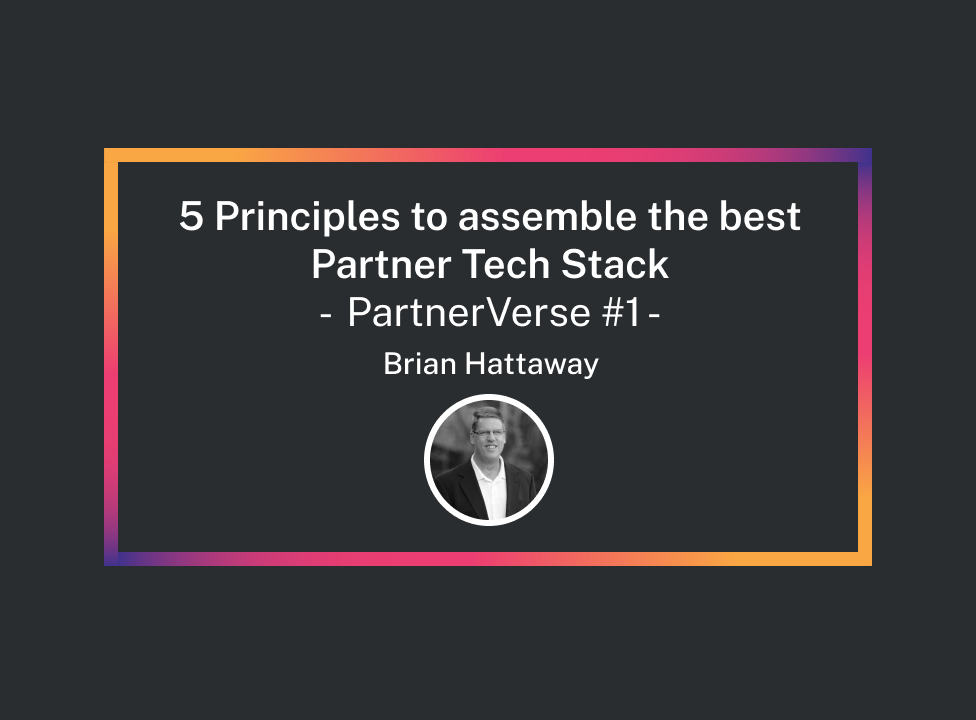Brian Hattaway is the Founder & Managing Partner for the ProCore Resource Group and also the Founder and Innovation Leader for IOLITE Solutions. He’s been providing consulting services on Salesforce integrations and solutions for more than 20 years, and he has a deep knowledge of the technical aspects of building and scaling a Partner Program. In this series of articles, Brian will explain his guiding principles to assemble the best-of-breed systems into a partnership program that is capable of scaling to manage at the enterprise level.

Creating a Reference Architecture for Partnering
My focus is to explore all the enablement technology that is available to partnering professionals – and ensure that the technology of the partnering universe matches up to the capabilities that partnering professionals need.
One aspect of this discussion is be centered around the creation of a reference architecture for partnering. Using the general principles of good system design – we’ll create a set of guidelines, principles, and standards so that partnering professionals can assemble the best-of-breed systems quickly into a partnership program that is capable of scaling to manage at the enterprise level.
But what are the key principles involved in the ideal partnering reference architecture? Let’s dig in.
5 Principles to assemble the best Partner Tech Stack
1- Your CRM is the heart of you Partner Tech Stack
Your CRM is the center of your partnering universe (or Partner-verse), and this should be your system of record for all partnering information. Do not manage your partnerships with a tool that operates separately from your CRM. You will never be able to report on partnership performance metrics if you segregate sales activity (managed in the CRM) from Partnering activity (managed on a separate platform).
2- Customize your CRM
You will have to modify your CRM and/or your procedures to effectively manage Partnerships. The native (direct sales model) CRM functionality that comes “out of the box” is not enough to manage Partnerships as well. We’ll explore the theory of how a CRM works, and highlight what changes need to be made to a standard CRM to allow it to work for Partnering.
3- Data is King
Data is the currency of power in partnerships, and there should be no tool in your arsenal that cannot share data with your CRM. Your best options for managing and reporting on the success of your partnership program rely on your ability to capture the data from 3rd party tools in your CRM so that all your critical metrics can be reported along side of all of your critical sales data (which is already in your CRM). We’ll look at aspects of connectivity that include API capability and data compatibility (a critical, but often overlooked aspect of connectivity).
4- Quality reporting should be automatic
One of the hallmarks of good system design is that reports are automatically available, and they are structured in ways that are meaningful and relevant to the business. One of the diagnostics we use to define the health of a system is the ease of reporting. Many partnering professionals spend hours (days?) creating Partner Business Reviews (“PBRs”). This is usually because of poor system design (they are cobbling together data on different platforms, or trying to deconstruct data that has been collected in non-standard ways). Good reporting comes from good system design, and we’ll explore ways to ensure that a PBR (and other reporting) is automatic.
5- Scalability is a critical design feature.
Scalability is a critical design feature. Setting up a partnership is only part of the battle. True results come from continuing to manage the partnership – encouraging bigger and better results. This means that the partnering platform needs to have the automation capability to support ongoing measurement, management, and performance of partnerships. This ensures efficient use of partnering professional resources.
Stay tuned as we explore each of these principles on how to design the best Partner Tech Stack in the next blog posts in this series.
Additional notes:
- You are welcome to connect with Brian on LinkedIn – mention Partnership Leaders in your connect invite
Join The 1850+ Leaders Transforming Partnerships
As a member of Partnership Leaders you will:
- Build and learn with the top partner people at the best companies around the world.
- Increase your impact and accelerate your career with proven resources, tools, and best practices.
- Grow a network of peers, partners, and advisors with common objectives.

